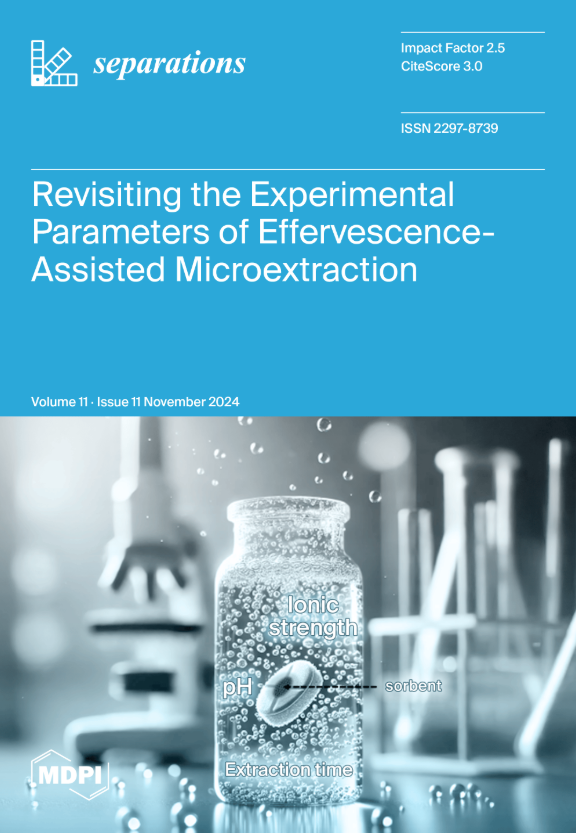Genomic and Proteomic Analysis of Pseudomonas aeruginosa Isolated from Industrial Wastewater to Assess Its Resistance to Antibiotics
IF 2.7
4区 工程技术
Q3 CHEMISTRY, ANALYTICAL
引用次数: 0
Abstract
Industrial wastewater usually contains a large amount of organic and inorganic pollutants, and many microorganisms. However, the types of microorganism present in industrial wastewater are still unclear. The aim of this study was to analyze the physicochemical properties and drug resistance of Pseudomonas aeruginosa isolated from industrial wastewater containing high concentrations of sulfate compounds. Pseudomonas aeruginosa was isolated from industrial wastewater from industrial produce with high concentrations of sulfate and phosphate, and mass spectrometry identification, gene identification, biochemical analysis and genomic and proteomic property identification were carried out. According to the results of matrix-assisted flight mass spectrometry and 16S rDNA sequencing, the isolated bacterium was identified as Pseudomonas aeruginosa, and was positive for reactions of ONPG, ACE, GLU, MNE, etc. Through growth experiments, it can be seen that Pseudomonas aeruginosa had a significant growth rate in the LB medium. Antibiotic sensitivity tests showed that Pseudomonas aeruginosa was susceptible to most antibiotics and moderately resistant to Polymyxin B and Polymyxin E. The drug resistance gene experiment showed that Pseudomonas aeruginosa had the gyrB gene related to antibiotic resistance. Proteomic analysis revealed that six proteins were involved in antibiotic resistance. This experiment isolated Pseudomonas aeruginosa from industrial produce wastewater containing high concentrations of sulfate and phosphate ions, providing a new perspective for further research on the characteristics and drug resistance of microorganisms in industrial wastewater and their potential functions when using them to deal with environmental pollution.工业废水中铜绿假单胞菌的基因组学和蛋白质组学分析及其对抗生素的耐药性
工业废水通常含有大量的有机和无机污染物,以及许多微生物。然而,工业废水中存在的微生物类型尚不清楚。研究了从含高浓度硫酸盐化合物的工业废水中分离得到的铜绿假单胞菌的理化性质和耐药性。从含高浓度硫酸盐和磷酸盐的工业生产废水中分离得到铜绿假单胞菌,并对其进行质谱鉴定、基因鉴定、生化分析、基因组学和蛋白质组学性质鉴定。根据基质辅助飞行质谱和16S rDNA测序结果,鉴定分离的细菌为铜绿假单胞菌,ONPG、ACE、GLU、MNE等反应均呈阳性。通过生长实验可以看出,铜绿假单胞菌在LB培养基中具有显著的生长速率。抗生素敏感性试验结果显示,铜绿假单胞菌对大多数抗生素敏感,对多粘菌素B和多粘菌素e具有中等耐药性。耐药基因实验表明,铜绿假单胞菌具有与耐药相关的gyrB基因。蛋白质组学分析显示,6种蛋白质与抗生素耐药性有关。本实验从含高浓度硫酸盐和磷酸盐离子的工业生产废水中分离出铜绿假单胞菌,为进一步研究工业废水中微生物的特性、耐药性及其在处理环境污染中的潜在作用提供了新的视角。
本文章由计算机程序翻译,如有差异,请以英文原文为准。
求助全文
约1分钟内获得全文
求助全文
来源期刊

Separations
Chemistry-Analytical Chemistry
CiteScore
3.00
自引率
15.40%
发文量
342
审稿时长
12 weeks
期刊介绍:
Separations (formerly Chromatography, ISSN 2227-9075, CODEN: CHROBV) provides an advanced forum for separation and purification science and technology in all areas of chemical, biological and physical science. It publishes reviews, regular research papers and communications. Our aim is to encourage scientists to publish their experimental and theoretical results in as much detail as possible. There is no restriction on the length of the papers. The full experimental details must be provided so that the results can be reproduced. There are, in addition, unique features of this journal:
Manuscripts regarding research proposals and research ideas will be particularly welcomed.
Electronic files and software regarding the full details of the calculation and experimental procedure, if unable to be published in a normal way, can be deposited as supplementary material.
Manuscripts concerning summaries and surveys on research cooperation and projects (that are funded by national governments) to give information for a broad field of users.
The scope of the journal includes but is not limited to:
Theory and methodology (theory of separation methods, sample preparation, instrumental and column developments, new separation methodologies, etc.)
Equipment and techniques, novel hyphenated analytical solutions (significantly extended by their combination with spectroscopic methods and in particular, mass spectrometry)
Novel analysis approaches and applications to solve analytical challenges which utilize chromatographic separations as a key step in the overall solution
Computational modelling of separations for the purpose of fundamental understanding and/or chromatographic optimization
 求助内容:
求助内容: 应助结果提醒方式:
应助结果提醒方式:


